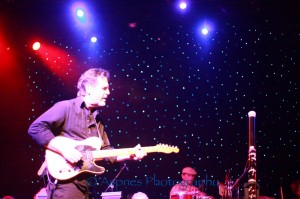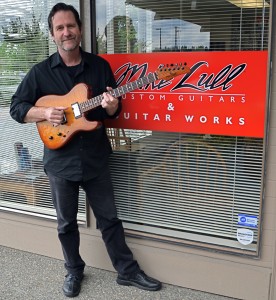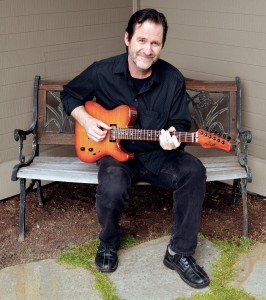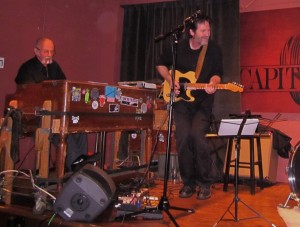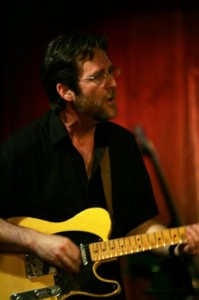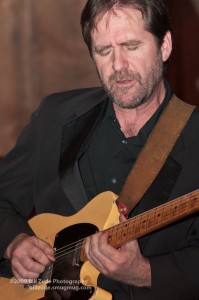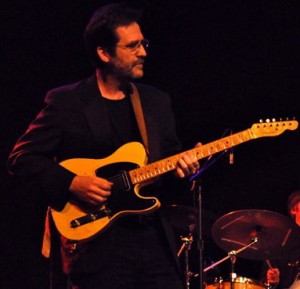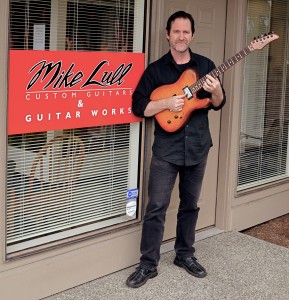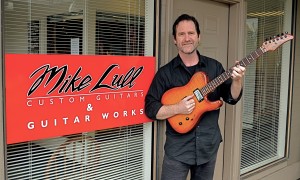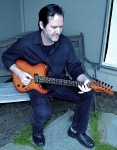
I’m (Doug Perkins) here with Tim Lerch in beautiful Anaheim California at the Portofino Hotel for the NAMM show and it’s January 23rd 2014. Tim is getting ready to be the demo guy for his new signature guitar in the Mike Lull guitar booth tomorrow – actually, they were demoing the guitar at the show yesterday as well, but Tim just got here today, and we just got back from eating dinner at Clancys Fish restaurant and had some great Blackened Ahi sandwiches. Tim is going to tell us about his new signature to guitar, the new CD he is working on, and his life with the guitar in general:
DP: Tim, I want to talk about your relationship with Lenny Breau, your experiences with Ted Greene and things like that, but you obviously do a lot of music work in a lot of realms and are very busy guitarist in Seattle, tell us about some of the work you do:
TL: Well, as I have done for much of my life, I balance between teaching and playing. So, I teach three days a week in my studio in Bellevue, and I carry a pretty good schedule from about noon to nine at night. I teach a combination of both in person lessons and Skype. So during a normal day, I might have a couple in-person lessons and one or two Skype guys. I mostly teach adults who are already players and want to “up their gameâ€, or something like that (laughs).  And then in my gigging life, I split my time between a number of pretty prominent Northwest acts: I play with Lee Oskar, who’s the harmonica player from War, and he’s got a band called “Lee Oskar and Friendsâ€, it’s a very nice gig, kind of a jam band. And I also write and record with him, he needs a right-hand man who understands harmony…
DP: Are you his M.D. (musical director) then?
TL: I wouldn’t go so far as to say I am the MD, but just that outside of the band, we have a writing partnership. And then I work with a great blues singer named Mark Dufresne, Mark sang with “Room Full Of Blues†for six years…
DP: Oh yeah, I have a friend that used to play with them…
TL: ….Yeah, and he was in the band when they were nominated for a Grammy, and he made two records with them. And he and I both came back to the northwest at about the same time, so that’s when we hooked up and started playing. We had a nice little trio plus a singer who plays harmonica, and he’s a great entertainer and a real fun harmonica player, and a great, great singer, and we do all original tunes. So in a scene where most people are playing covers, we’re playing originals and staying relatively busy. I also played with a guy named Danny Vernon, Danny Vernon was voted the number five in the world Elvis tribute artist. He’s endorsed by Graceland Enterprises, which is the Elvis Presley estate, and we just finished a weeklong run in a casino near Seattle. So he keeps me pretty busy, and it’s a great band, and it gives me the chance to play all that great old Scotty Moore, Hank Garland, and James Burton stuff that I love so much. It’s just a great Telecaster gig!
The Musical director for that band is very ambitious, so we do gigs where we do all sorts of themes – like we do the Blue Hawaii show, or we do various things where we have to learn a whole bunch of tunes right before the gig, and that’s always good because I don’t get that many chances to use that part of my musical training – you know, reading charts and that whole thing, so I enjoy that, it’s a great gig and they take care of us well and it pays well.
I play with three different singer’s – just me and a singer, or sometimes adding a bass player and singer – And I play a lot of solo gigs. So between all of that I’m playing two or three gigs a week – rarely is there a week where I don’t have at least two gigs – and then as if I have anymore spare time, I write articles. I write a quarterly article for Fingerstyle 360 magazine, and of course I am creating videos for JazzGuitarSociety.com, which I hope to do a number more for this year.
And of course I have the signature guitar which is coming out and debuting this weekend at the NAMM show.
DP: Talk a little about that, what makes this unique? The main thing I saw right away is that it’s much fatter then a usual guitar.
TL: Yeah! Basically I discovered about 10 years ago that I liked the “Nocaster† from the Fender custom shop. One of the things that I really liked about them was that they have this nice big neck – the neck is about .9 inches thick at the nut, and it doesn’t change-it’s .9 inches thick At the 12th fret as well. So unlike most the guitar is in the world that have about a 25% graduated depth in the neck, this one is the same all of the way up. So that’s one thing about it that is not as common. It is a two inch thick guitar where as most Teles are about an inch and a half, and in order to make a mahogany body / maple top guitar not weigh 15 pounds, we hollowed it out. Not so much for the acoustic properties, although it ends up having that, but we hollowed it out all the way around except for behind the pick-ups and the bridge. So it has a solid body response with the maple top, so the notes jump out really quick. But then it’s got this “hollow body bloom†after the note jumps out quick, it blooms, so it’s very interesting!
DP: Sort of like a 335?
TL: A little bit but it’s not nasally like a 335, it’s very open and rich. I’m a Lollar pickups endorser so It’s got Lollar Imperial Pickups in it. It’s my only humbucking guitar, I wanted a telecaster that felt like a telecaster  that I could use on jazz gigs  and have it be really clean, and use it on B-3 organ gigs and really be able to bash on it. So once I designed it- well, you can’t really say I designed it, but I did drew some pictures of what I wanted then showed it to Mike and he said “yeah we can make thatâ€. So they made one and they said†we like this a lot, would you like it to be a signature guitar, and how would you feel about it if we put a version of it in our line?â€. So over at the show they have one with P 90s and one with Gretsch Filtertron pick ups and a Bigsby, they have the thickness in the body but the standard Lull  neck. So they put it in the line and it’s called the TX-Chubby – I named it Chubby because it looks sort of “overweightâ€â€¦
DP: Yeah, it looks maybe a quarter again as a standard Telecaster.
TL: Yeah, it’s an extra half of an inch thicker. This particular guitar of mine has a short tele style bridge with three brass barrels made by Glendale, but Mike’s going to make the Chubby with a Les Paul type bridge. And for me I was craving a Les Paul, but I can’t play a Les Paul for a number of reasons including the short scale. This is 25 ½ inch scale, and a 9 inch radius which is a little bit rounder than a Les Paul – so this is kind of my version of as close as I can get to a Les Paul – and it’s pretty, it’s got “flamey stuff†on it – it’s a “gentleman’s guitarâ€.
DP: Now you were just talking about your B-3 trio, is that the band you are using on the record that you are working on right now?
TL: I do have a CD project that is in pre-production right now. I haven’t decided yet whether I’m going to do a solo guitar record and have it stand separately form the B3 record, or do a B-3 record with solo guitar “vignettes†within the B3 tracks. I’m a little cautious about a whole record of solo guitar, because in as much as it’s something that  is very iconic for a guitar player to do, very rarely have I heard one that keeps my interest, so I am doubtful as to whether or not I could keep my own interest (laughs).  But to do little 2 minute things in between the funkier tracks might be interesting, so I will do one or the other – and I know that if I keep talking about it that sooner or later it will force myself to do it (laughing). So let it be said that I am hoping to have it done by somewhere around mid year. (Update: in July Tim is going to record with Sheldon Gomberg at Sheldon’s studios in LA)
So a couple of other projects that are looming are a record of my playing and singing standards, kind of like my version of Harry Connick Jr. or something like that – but just guitar and voice. I really love the challenge of that. And also a jazz standards trio record, there’s some really good players up north that I want to work with. So all of those things, but the B-3 record and the solo guitar thing are the priorities for this year.
DP: The little bit that I’ve heard was almost sort of a “jump blues†kind of thing…
TL: Yeah, I love that – you know, I’ve always loved jazz, but these days, almost more than playing things like “Stella By Starlight†and “Giant Steps†and stuff like that which I did in my youth, I’m really feeling like I want to dig into this sort of jazz inspired blues – there’s a simplicity and an earthiness to it that I really love that really says something to me. And I can sing in that style and play in that style, so that B-3 record will probably have a couple of vocals on it.
DP: Now, you and I know each other from Musicians Institute – we weren’t students at the same time, but I think that we had a little overlap while we were both there teaching there…
TL: You were teaching there when I was a student, and then I taught summer sessions while you were still there.
DP: OK, I was sort of right then! So, describe your early days, then: what made you decide to be a musician, and how did your transition where you decided to go to Los Angeles happen?
TL: Well, it’s funny how it happened – I didn’t decide to be a musician, one day, it was just the case!  I think that I always wanted to be a musician, the only thing that really mattered to me was music, music, music., and then one day I realized that I better get around to playing something. I sang and played harmonica and I thought that that would be enough, but it wasn’t and I got a guitar when I was 13 and then it was all over – it was like you know “I’m a guitar player nowâ€. Any you couldn’t talk any sense into me then, I didn’t want to go to college, I didn’t want to do anything sensible – you know, I come from a working class family, so there wasn’t a lot of pressure to go to college. I have siblings ahead of me, all who went, and so when it finally came around to me my parents were maybe a little  tired, so they didn’t force me to do anything. So I just started playing gigs and teaching from when I was about 16 years old, and that’s how I’ve been doing it ever since.
DP: So what was the transition to go to MI – what happened?
TL: I got married to a woman whose family lived in Los Angeles – we got married while I was living up north in Davis CA, but she had family down here so it was in the realm of possibility. I had gone to a Howard Roberts Seminar, and that was my first real instruction, because I had just been doing it on my own – there really wasn’t anybody to teach me.  He came to Sacramento and Pat Hicks was with him and he did this two or three day thing. And I remember one of the things that I learned  was a ii V I kind of move that sound like Tea for two. – I recently recorded a video of “Tea For Two†that I called “Tea For Tedâ€, and it’s sentimental, it’s an old song – it’s a DUMB old song….
DP: It’s HARD though!
TL: It has it’s quirks – but Howard taught us this: (plays a simple chord melody of the opening phrase of “Tea For Two†on the top three strings) – my first II-V-I, right?  So from way back when, my early high school days, “Tea For Two†has always been a cool thing. And then George Van Eps did a version on this record called “Jump†– it’s an old record where he played an acoustic guitar and he played in a band but there are three or four solo guitar tracks on there as well. And he did a really pretty re-harmonized version of “Tea For Twoâ€, and he’s another early influence.
But anyway, to get back to GIT (Guitar Institute of Technology, now Musician’s Institute),  I went to Howard’s seminar and I had it on my mind because, he was really the only educator that I know at the them, there really wasn’t that many. I didn’t know where to go, so I went to take some lessons from an older guy in my town, and he didn’t have it together enough to teach. I had been playing since I was about 15 with the older retired guys in my town – there was a guy named Emmet Pugh, and he played jazz on the fiddle, one of the great western swing players. And Tiny Moore, the great mandolin player who played with Bob Wills lived the next town over. So that was kind of the scene I grew up with, western swing California style – kind of like Bakersfield once removed.
But I didn’t really find any jazz guitar players who could teach me. So when I was in LA I found Ted Greene. So one Thanksgiving weekend I managed to do a lesson over at Ted’s parents house. He and I had been corresponding by mail prior to that, and I asked him about it (GIT), because I really loved Joe Diorio, and he said, “well, you have to decide if you want to study in a group environment or notâ€, because he wasn’t an advocate one way of the other, I think he had mixed feelings about it.  But I met somebody in Sacramento that either met Joe (Diorio) or played on a record with him or something like that, a guy named Michael Mousillani, who played with him in New York. So I really got excited and said “I can go and take lessons from  Joe Diorio? Holy….†So I just figured it out and went.
DP: But how did you even find out about Joe Diorio?
TL: Well, every once and a while you just find a little scene, and those were the days where Joe had two records out, the blue one (“Peaceful Journeyâ€) and the black one (“Solo Guitar”).
DP: Right, the Spitball (Records) stuff.
TL: And you could find maybe in a cut out bin a copy of the Sonny Stitt “Move Over†record, and maybe Eddie Harris “Exodusâ€. So I did a lot of research and you know, you just hear about stuff – I read everything, I read Guitar Player magazine voraciously, and I memorized every article. YOU know, how did YOU do it, you just put your ear to the ground and then…..
So we went to LA and we moved to Hollywood, and my relatively new wife got a job in some computer company, and I rode the bus up over from La Brea and Melrose to the school. And its’ funny because more of the guys that went to the school were bachelors who were on their wild year away from home, and I was in another thing: I would go home to a wife and a little house in a duplex. So I didn’t really do the “go crazy and be a wild man†guitar thing.
But I sure did spend an awful lot of time in Joe Diorio’s office. And Ronnie (Eschete) would be there for one week on and one week off, and then Joe would be there one week on and one week off – when they were there, that’s all I did, I just sort of like latched on to them.  I don’t even know if they hated it or didn’t care or liked it; but for me it was just like….my cohorts would say “He’s a Diorio puppyâ€, but I didn’t care because that’s what I was there to do. I didn’t really go there to learn what a harmonized scale was because I already had a lot of that stuff together. I talked to Pat Hicks about that recently, and I really didn’t connect with the overall philosophical concepts of learning at the school, but I really did love getting to hang out with Joe and Ronnie and guys like Lenny Breau, and play and hang out with Scott Henderson, and meet the cats, you know?
DP: I know there is stuff written in other places about your time with Lenny Breau, but touch on some the unique things that people might not know.
TL: Well, I got Lenny’s number somehow…he was staying with a guy…I think his name was David Rose…and if I remember correctly, David Rose was a guitar player on the scene, an older guy, and he knew Lenny. So somehow a lesson was arranged, and I showed up at this guys house somewhere in the (San Fernando) valley, and when I get there Lenny’s not there, but a couple of minutes later I see this little gnome walk over from the Safeway or whatever for some cigarettes or something. And one of the things I remember was that I said “Hey, Lenny†and he shook my hand like this (partial taking of the palm so as to not allow squeezing) not like that (full palm grasp) – he put his thumb down so I couldn’t break his fingers or break his nails.
So I had an ES-175 and he had an Ovation guitar that was like owned by the guy who lived there, and we didn’t plug in, we sat there across from each other at the table, and he asked me as many questions as I asked him. And if I recall, at that time of my life I was quite full of “piss and vinegar†as a young man, and could play pretty good, you know; but it was humbling and cool and we had a nice rapport. Lenny didn’t teach in any particular way, it was more like hanging out with Lenny and then sharing some funds with him.
So I gave him some money and I think it was like a two hour lesson. And then the next time I saw him he came to GIT, and he and Joe and I went out to lunch and that was really fun. At some point he moved to LA and I went to see him – he had a round of gigs at Dontes (old San Fernando valley famous jazz club) – and one of the first gigs he did down there, John Pattituchi was on bass, when John was probably about 12 years old or whatever (laughs). And Lenny just came over to my table because he recognized me, and I said “Hey Lenny, what’s going on, I’d like to have your telephone number so I could come over and take a lessonâ€. So he said “yeah, yeah†and I still have that little piece of paper that he wrote his name and telephone number on.  So then he introduced me to John who was like “Hey, man, how you doing?â€, very nice…
DP: Yeah, that’s John….
TL: Yeah!! So then I started calling Lenny up, but it still was difficult because I was at like LaBrea and Melrose and he was on Wilshire at like Pico or something, I can’t remember exactly, but you know, twenty blocks up and a few blocks over. So I would go over there…here’s a funny story: One time Lenny calls me up and says (imitating Lenny’s voice): “Hey, like Tim..like…like do you think you’d like to come over for a lesson, man?â€
DP: (laughing) Yup!!
TL: And I said, “Sorry, Lenny, man, I don’t have the car today and I have something else going on, I have a rehearsal, sorry I can’t make it but I’ll call you real soon and I’ll get over thereâ€. So he says, “OK, man, coolâ€, and he hangs up. Ten minutes later the phone rings again, and it’s his wife, and she says, “Hello Tim, this is Lenny’s wife – do you know where Lenny is?â€
DP: Wow…..
TL: So that was sort of a harbinger….(laughing) And then sort of the final thing – and I haven’t told this story in public, but I guess I will…..I arranged a lesson with Lenny and I had a 7 string classical guitar at the time with a high A string on it, and I really wanted to learn that…
DP: That’s what he had at the time…
TL: He had that and the Kurt Sand seven string. So I arranged to go meet him on a Thursday afternoon and I got over there around 2pm and we spent until around 5pm, and I met his wife for the first time and his little daughter, they came and went.  We had a wonderful afternoon and I got a chance to play the Kurt Sand electric seven string, and we played some duets and talked about this and that. We mostly talked about voicings, like how to get cool voicings for this chord in this song. He was real song oriented, so he didn’t talk about systems like Ted Greene would talk about, Lenny would talk about a particular chord in this or that song: “check out this new voicing I got off of a Bill Evans recordâ€, he would say….
DP: Oh, I get it…
TL: after we had a great afternoon playing he showed me the swimming pool on the roof,  he was all tan and pretty fit, he was staying “clean†at the time and didn’t exhibit any inebriated behavior, he didn’t disappear for a half an hour in the middle of the lesson or anything like that. So he told me that he was sitting by the swimming pool practicing a lot and and then he walked me down to the lobby and said goodbye. The next day he did a seminar at GIT which is well documented, there’s some tape, and Joe Diorio drove him home from the seminar that day and he talks about that in the book about Lenny called “One Long Tuneâ€. There’s a story that Joe talks about from that drive home, and the next day they found Lenny at the bottom of the pool dead. And so that was hard for me, I had just seen him and was right in the throes of my sort of “romance†with him, you know, that sort of youthful hero worship, and then he was gone.
I just talked to a guy – Paul Calisnicow – Paul was in the class after me at GIT, he is a really good rhythm guitar player, Joe Pass told him that he was the best rhythm guitar player that he’d heard at the school, he did the sort of Freddie Green style.  And I just talked to him two days ago and he said “You know I went out to lunch with Joe and Lenny on the day of that seminarâ€, and so that was just one more connection to the whole thing – they went to that natural food dinner that we always used to go to and had a tuna salad with carrot shavings on the top. Anyways, that’s my Lenny story. Since then I’ve been in touch with Lenny’s  daughter Emily Hughes and shared a lot of these things and she’s been very kind and supportive.
DP: She’s got a couple of movies out on him…
TL: Yeah,  there is one movie that is out and sort of out of print and now she is working on a re-cut and sort of at a stall right now – she’s a nice lady…..
DP: So you taught at MI a little while….
TL: Well, I’m hesitant to say that I taught at MI, a lot of guys taught there, but I really just taught some private lessons during the summer sessions there.
DP: OK, so after you taught there, did you play around LA for a while?
TL: Well, I went on the road with a band that (former MI teacher) Ed Finn turned me on to, The Diamonds.  So I was on the road with them a couple of years and I got Bart Samolis a gig playing bass with them, it was Bart’s first bass gig. I called him up and said “Hey Bart, you doing anything?†“Not really.†“You wanna play bass in a band and tour?†“Alright – I better go buy a bass.†“You can borrow my ampâ€. So that was it, he sight read the charts perfectly and he held the gig even longer than I did.
DP: Bart was my guitar student at MI and a great reader and overall guy, when he switched to bass I hired him for my fusion band because he understood the harmony, all the bass players I had auditioned didn’t understand the chord scales and were playing totally wrong passing notes. He’s burning it up in the LA studios now, he does Mad Men, the Oceans 11 stuff, on and on.
TL: Yeah, he’s great! So I lasted a year and half until my lady at home said “dude, I didn’t get married to be single at home by myselfâ€, because it was like 6 weeks out, three days in – so I decided to come off the road. I did a few nice gigs like playing in a Russian restaurant in Beverly Center for a while, and we kept moving further south because of one reason or another and we ended up in San Pedro, And I wasn’t really nailing it, I was playing a lot of gigs that weren’t so interesting, but I was learning how to play country music which was probably a good thing. And then  we had one kid and another on the way, so it seemed like we really weren’t prospering so we just got a wild hair and moved up to Seattle, and that was in 1989.
So I played country music for what I lovingly call “the Garth Brookes scare of the early 90s†(Both laugh long and loudly)
DP: When everyone thought that EVERYTHING was going to be country from then on….
TL: Yeah, the line dancing and all of that – it was sort of like “Urban Cowboy / Mach IIâ€.  But that was good, at least I played a lot of guitar – country music lets you play a lot of guitar.
DP: Yeah that’s true for sure! So, at least for a while you were teaching for Jay Roberts, Howard’s son, right?
TL: Yeah, that’s true. Just to back up for a second, in 1995 I had to take a break, I stopped teaching and I stopped gigging and pretty much got out of music, and I lived in a meditation center. I just got off the grid, you know, and I moved to Rhode Island and just got healthy in a way that I hadn’t gotten as a young man playing guitar. But then that chapter came to an end and I was ready to get back to playing music, and Ted Greene had died and it was just one more reason for me to get back to playing. Joe (Diorio) had had a stroke and I was thinking “Wow, all of my mentors are leaving, maybe they’re leaving it up to the younger crowd, so maybe it’s our turn to really push itâ€, you know?
So I came out of the monastery and let my hair grow back and tried to figure out how to earn a living (laughs), and at first I went to Gainesville, FL and hung out there for a while, But then I came back to Seattle for a couple of reasons, mostly because my people are there, and I walked into Mike Lull’s place to say hi, and he said “you ought  to go over and talk to Jay (Roberts) if you are looking for a gigâ€. And I hadn’t completely convinced myself that I wanted to get back to teaching, but I went over to Jays place and there was nobody there, but I heard something happening inside so I went around to the corner and there was a teaching studio with the door open and there was Don Mock (founding instructor at MI). And he says, “I know you!â€
DP: That sounds like Don….
TL: And so he recognized me – I didn’t really spend that much time with Don back in the day, but he recognized me. So a couple of days later I came back and met with Jay and he was happy to have me come on board and we had a very nice run. I taught a lot for him at first and built up a big schedule, but then I wanted to diversify a bit, so I started expanding my own private studio and trimming back his. So eventually I just had one evening there with 4-5 students and I had to pull the plug on it. I think we left amicably and he’s a good guy and has a great operation there – I think I taught there from 2006 to 2012 or so.
So in September of 2012, Mike Lull said “hey Tim, we are going to expand the shop and we will have a little spare office in front, do you want us to make that into a teaching studio for you?† So I said “sureâ€, and they made it for me and now I have my own place. I can leave my guitars and my gear and my computer and can just close the door and lock it, so it’s great. So I stopped teaching in these various places and just do everything there.
DP: Cool! You do a lot of product demo videos as well, right?
TL: Yeah, it’s something I started doing because I liked Lollar pick-ups and I wanted to help them because they were just starting to be on the map, you know, and they had VERY good stuff and they’re local. So I started doing it because I wanted to be involved with them, I loved their product and I put them in my guitars and I just wanted to help. My idea was that you start doing something because you love it and if there’s going to be any rewards from something then they’ll come. So I did some demos of their Charlie Christian pick-up for telecasters – I was an early user of those pickups and then they asked me to do more and more, and then other guys (gear manufacturers) started asking me to do things, and I discovered that being on YouTube – you know, I’m not touring, I don’t have a lot of records out , but I feel like I have something to offer and I want to have a venue for it.
So YouTube is sort of cool for that, I and I figured out how to monetize it to some extent. there’s no real model for it, and to be honest with you I don’t want to do it to get gear and re-sell it. So when people contact me from time to take and ask me “would you like to demo something of ours?â€, I say “send it to me, and if I feel like I like it and will use it, I will keep it and make a nice demo for youâ€. And if I don’t like it and it’s not my cup of tea, I will say thank you very much and send it back. And people like that and usually say to keep it either way. But most of the demos just start with me wanting to share something I like, and then it may go further from there.
I want to have integrity with my subscribers, so I don’t want to be a guy that just reviews everything that comes down the pike. There are guys that do that and I think they do a good job, they do it with humor and everything and people just want to find out what such and such sounds like, but I just don’t wanna be a full time video guy.
DP: So you have a YouTube channel? How many subscribers do you have?
TL: I have a YouTube Channel with around 3,000 subscribers now. So that means that whenever I do something, they get an email. My first YouTube video I did in 2009, which was called “Why Do Piano Players Have All The Fun?â€, which was just a really fun solo guitar thing that got a really nice response that encouraged me to do more of it. Now my channel has almost a million views.
DP: You pass that million, I guess you get some money….
TL: Well, I actually figured out how to make money off of that. For a long time I didn’t want to do it, I probably should have – I didn’t put ads on my videos but now I do, and that generates a little bit of income.
DP: Well, this is a very interesting thing for a lot of guys coming up to figure out how to put together a diverse portfolio of work!
TL: You have to, you know? I would go stark raving mad if I had a 5 night a week gig at the same joint or taught the same class at a university every season. I just like exploring different stuff and like to have enough flexibility in life to explore my whims, and so a lot of it just comes form not wanting to be bored. Curiosity is a big driving factor for me – students will ask me, “how do I know if I am really making progress?â€, and I will say “you can work hard and have a good teacher and all of that, but the most important thing is being curious, because THAT’S the thing that’s going to keep you going.
DP: Well, a major arrive area for most any guitarist is to get to where they have their own signature model guitar….
TL: Yeah! (chuckling)
DP: So you’re looking forward to playing that all weekend in the booth, right?
TL: Yeah, I’m looking forward to it, actually this guitar is very wonderful and guitar and it’s really a great guitar for playing my style of solo guitar…
DP: I thought it was great for that when I was playing it….
TL: And I can put a lighter set of strings on but it’s still firm and comfortable enough in my right hand. My approach to solo guitar but actually guitar in general is that I like long notes, and I like notes to ring over each other.  I’ve for my whole life tried to figure out how to get the effect of holding down the sustain pedal on a piano and playing something against the sustained notes, and that’s why I play telecasters instead of a 175. And this guitar seems to have that quality where I can hold the notes a long time with a nice light touch without killing myself. So I am looking forward to playing at the NAMM show – I’m not going to play hour after hour, just a couple of times a day and I brought my looper so I will use that as well and so some funkier things so people can hear different aspects of the guitar.
DP: I’m looking forward to seeing what you do, let me know your schedule and I will come by.
TL: Yeah, we will do a duo or two!
DP: Well, is there anything else I missed here?
TL: Well, one more thing – I really think it’s important for me to talk in a larger venue about people that have been supportive and helpful to me.  I’m sort of know around the inter-webs as a kind of a “tone guyâ€, and I’ve worked hard to make my guitar to SOUND good, and of course if you’re an electric guitar player you need to have a good amplifier. And I have a guy whose made an amplifier that I had a little input into and I have been his tester and his name is Paul Spitalny, and he has  a company named SunnySide Amps. He makes a very nice, very simple 40 watt 1×12 Fender type amplifier that’s clean – you know, I use pedals in front of the amp for my overdrive and things like that, to the extent that I use overdrives these days – and it’s just a wonderful amp, it’s very pretty to look at and sounds great, it’s been really, really robust in terms of all the throwing it in and out of the car. The microphone loves it and the sound men love it,  so I want to give a shout out to SunnySide Amps for allowing me to use that amplifier. I’d love to see Paul sell a lot of these, he’s developing a smaller 22 watt version, but it’s a beautiful sounding amp and it’s on a lot of my demos lately, so if anyone wants to hear it they can look on my YouTube page and there’s a number of videos there with it in them.
DP: Well, thanks, man, this has been a great interview and I am looking forward to seeing everything you do with the guitar tomorrow at the show.
TL: Well, thank you, and you have bee supportive of this “diverse income stream†as well. The master class videos for JazzGuitarSociety has been really good for me because I’ve been able to reach people that I normally wouldn’t be able to reach, and I think that the videos I have made for you guys have held up and they’re not another video about how to play a solo over a II-V-I….
DP: Nope!!
TL: Well, it’s my sort of weird version of it anyways, and this year I look forward to doing more, at least one every other month, because the response has been really good and you guys are running a good show – you’re fair to the artists which isn’t always that case…it’s amazing how little money the artist is left with after everybody takes their chip! So I’m planning a volume two of “Two Note Accompaniment†and a walking bass line and a contrapuntal comping video as well, exploring the finger style side of jazz playing.
DP: Well, we love you because your work ethic is great, your playing is impeccable, and people love what you do…
TL: It’s all just fear, Doug….
DP: Fear of sucking! (both laugh)
TL: I practice a lot because I don’t want to suck, and I work a lot because I don’t want to starve! (laughing)
DP: And in that way, fear is a good thing – maybe we should leave it at that!
TL: That’s right! Thank you, Doug.
For more on Tim Lerch , go to:Â www.timlerch.com
